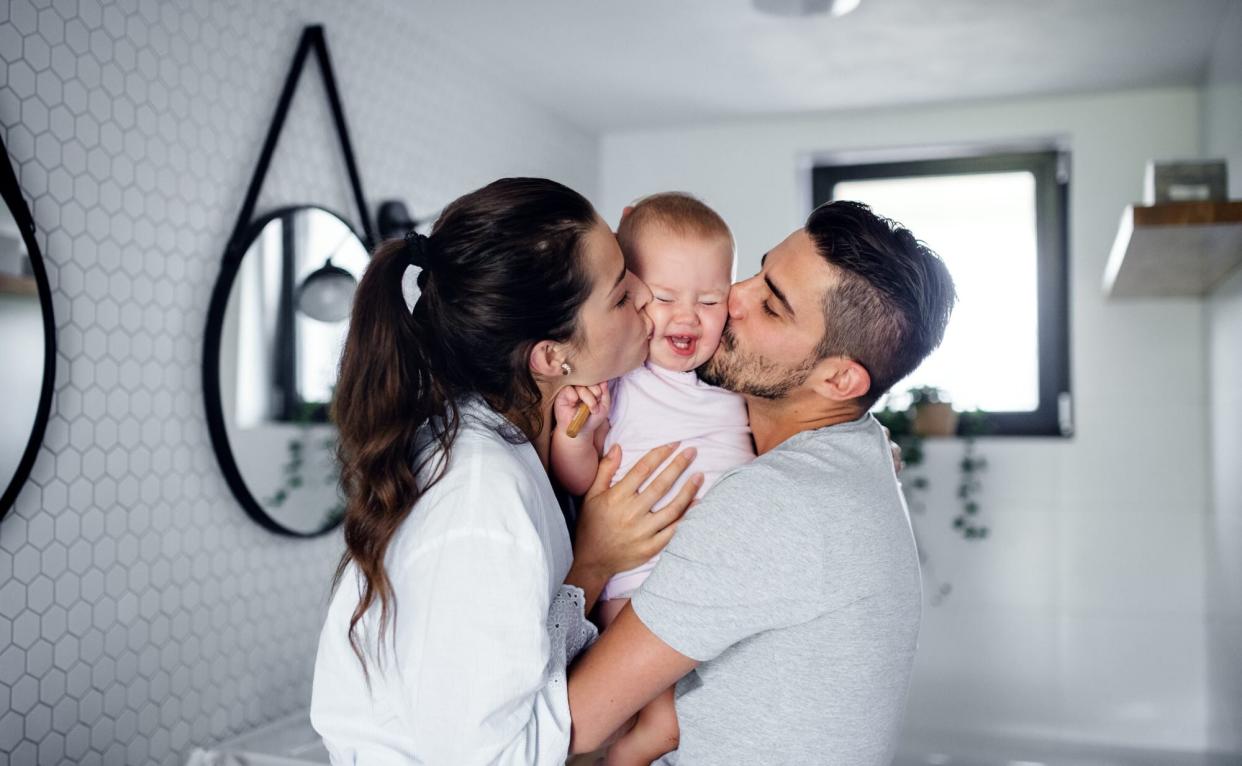In the Genes: Where Baby's Looks Come From

Getty Images
When you're pregnant, it's fun to speculate about your future baby's appearance. What will their hair look like? Will they have blue eyes or brown eyes? But while parents can't help but make predictions, they can never be 100% sure until after the baby actually arrives. "If we examined all a fetus' DNA, we still wouldn't be able to truly anticipate things," says Barry Starr, Ph.D., geneticist in residence at The Tech Museum, in San Jose, California. "So much is unknown about genes."
Still, scientists do have some understanding about why people develop the features they do. Here's everything parents need to know about what their baby might look like.
What Will Your Baby's Hair Look Like?
Individual people inherit multiple gene pairs that play a role in determining hair color (and each pair includes one gene from each parent). If a baby inherits 10 pairs of genes in all, for example, that means 20 different genes could affect their tresses, says Michael Begleiter, a genetic counselor at Children's Mercy Hospitals and Clinics in Kansas City, Missouri.
But scientists haven't yet determined how many genes ultimately decide someone's hair color. If two brunette parents produce a blonde baby, that means both parents carry recessive blonde genes among their dominant brown ones, but only their light-colored genes were passed on. "When sperm met egg, the right mix of genes popped up so it could be expressed," says Dr. Starr.
The genes that set hair color (as well as eye color and complexion) also regulate a person's melanocytes, or color-producing cells. Where a baby's hair color will fall on the spectrum from black to brown, or red to blonde, may be determined by how many melanocytes they have, how much of each shade they churn out, and what pigment those make (one type, eumelanin, produces black to brown; the other, pheomelanin, makes yellow to red).
RELATED: Your Baby's Alertness in the Womb
The more color-producing cells a child has, and the more eumelanin those cells make, the darker their hair will be. If they have relatively few melanocytes that mostly manufacture eumelanin, you can expect light brown or blonde hair. And the more pheomelanin their cells produce, the redder their hair will be.
Of course, hair color isn't necessarily stable over time. A child's hair may undergo changes as they age, especially as they hit puberty when hormones can activate genes that cause it to darken or curl.
What Will Your Baby's Eyes Look Like?
Some babies are born with bluish-gray eyes, but that can change as they grow. In fact, unless a baby's eyes are very dark at birth, they will typically change. And it can take at least six months before an infant's eye color stabilizes. "The color-producing cells in the iris need exposure to light to activate," says Dr. Starr.
RELATED: When Do Babies' Eyes Change Color?
At least two genes influence the eye shade that develops, and each can come in two forms, or alleles: one that has brown and blue versions, and one that has green and blue versions. A baby's eye color will depend on the combination of alleles they inherit from each parent.
If one parent has dark eyes and their partner's are light, the baby is likely to end up with dark eyes as well. That's because the brown allele is dominant, so if a baby gets one, they'll develop brown eyes. Still, even two brown-eyed parents can produce a light-eyed child if they both carry recessive blue genes.
What Size Will Your Baby Be?
It's difficult to tell what size a baby will be since a newborn's measurements don't necessarily predict their future height and weight. Many factors can influence size at birth, including the pregnant parent's diet and health conditions, such as gestational diabetes, says W. Gregory Feero, M.D., Ph.D, a family physician and special advisor to the National Human Genome Research Institute of the National Institutes of Health.
More than 100 genes code for height, and regardless of a baby's initial length, they will probably grow to their genetically predisposed stature. The exception is kids who have poor nutrition and little physical activity, as they tend to be shorter despite their genetic potential, says Dr. Starr.
Parents can make a rough estimate of their child's future height by using their own. For children who are born female, subtract 5 inches from their father's height and average that number with the other parent's height. For children who are born male, add 5 inches to their mother's height and average that with the other parent's.
Another way is to simply follow a child's growth curve. "If [they're] consistently in the 50th percentile for height and weight, it's likely [they'll] be close to that as an adult," says Begleiter. Of course, it can always change.
Which Parent Will a Child Look Like?
Sometimes children end up looking exactly like one parent, or even closely mirroring a sibling, and sometimes they don't resemble anyone in the family. It's all entirely possible.
Kids share 50% of their DNA with each of their parents and siblings, so there's plenty of room for variation. If siblings end up looking alike, the mix of genes they inherited was similar. But each child may also get instructions for different features: A firstborn child may have one parent's lips, while the youngest may get their lips from the other parent.
In fact, a child's bone structure won't be set until in their 20s because so many genes are involved, including those for growth, bone development, and fat deposits. Until then, parents just have to sit back and enjoy the slow reveal.

